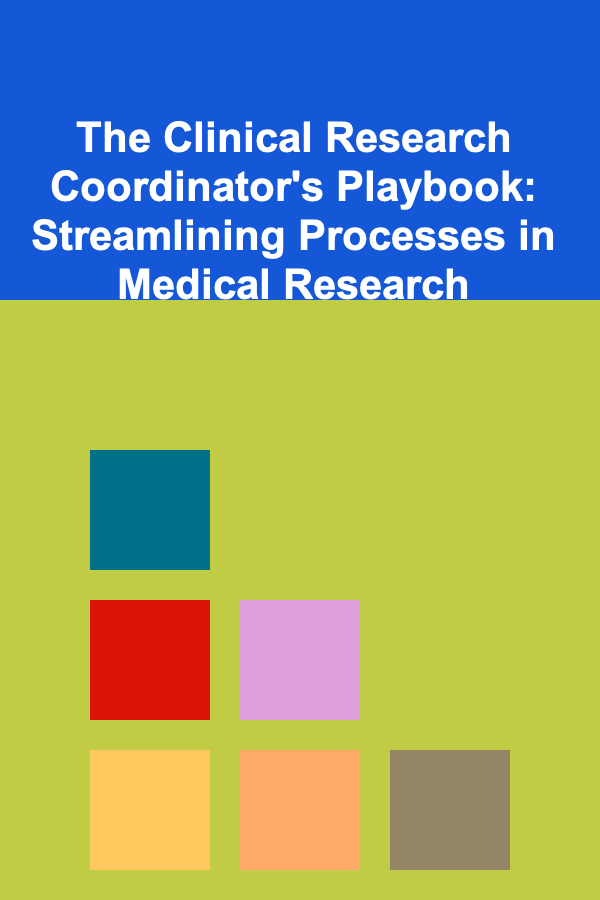
The Clinical Research Coordinator's Playbook: Streamlining Processes in Medical Research
ebook include PDF & Audio bundle (Micro Guide)
$12.99$6.99
Limited Time Offer! Order within the next:

Clinical research is a cornerstone of medical advancement, driving discoveries that improve patient care and treatment outcomes. However, the complexities and intricacies of medical research can often pose significant challenges for clinical research coordinators (CRCs). As key figures in overseeing clinical trials and studies, CRCs play a pivotal role in ensuring that research processes are efficient, compliant, and aligned with scientific goals. This actionable guide aims to equip CRCs with practical strategies to streamline processes, reduce inefficiencies, and enhance the overall quality of clinical research.
Understanding the Role of a Clinical Research Coordinator
A clinical research coordinator is responsible for managing day-to-day activities in clinical trials, ensuring that research is conducted in compliance with regulatory guidelines, and supporting the research team to achieve the study objectives. Their tasks include patient recruitment, maintaining regulatory compliance, monitoring study progress, and ensuring accurate data collection.
Key Responsibilities of a CRC:
- Patient Recruitment and Retention: Identifying eligible participants and ensuring their continued engagement throughout the trial.
- Regulatory Compliance: Ensuring that all protocols, ethical standards, and regulations (e.g., Good Clinical Practice (GCP), Institutional Review Board (IRB) approval) are strictly adhered to.
- Data Collection and Management: Ensuring that data is collected accurately, securely, and in accordance with the study protocol.
- Liaison between Teams: Acting as a bridge between investigators, research staff, sponsors, and participants.
- Quality Control and Monitoring: Ensuring that the trial progresses according to schedule, within budget, and with high-quality data.
Streamlining Recruitment and Participant Management
Recruitment is often one of the most time-consuming and challenging aspects of clinical research. Efficient patient recruitment strategies not only speed up the trial process but also ensure that the study is representative and scientifically valuable.
a. Optimizing Recruitment Channels
Efficient recruitment can begin by identifying the most effective channels to reach potential participants. These may include:
- Patient Referrals: Establishing relationships with healthcare providers who can refer eligible patients to clinical trials.
- Community Engagement: Hosting informational sessions, webinars, or community outreach programs to raise awareness about ongoing studies.
- Online Platforms: Using patient recruitment platforms and social media to engage a larger audience.
- Clinical Trial Registries : Listing trials on global databases such as ClinicalTrials.gov can help patients find suitable trials.
b. Pre-Screening and Eligibility
To streamline the recruitment process, CRCs should develop effective pre-screening procedures that help quickly determine patient eligibility based on inclusion and exclusion criteria. Using electronic health records (EHR) and screening tools can speed up this step by automating much of the initial data collection and reducing manual entry errors.
c. Enhancing Retention Strategies
Once participants are enrolled, retaining them throughout the trial is crucial. CRCs should employ strategies that maintain participant interest and involvement, such as:
- Clear Communication: Regular updates about the study's progress, findings, and any changes to the protocol.
- Incentives: Providing compensation for time and travel can motivate participants to remain involved.
- Personalized Follow-Up: Ensuring that participants feel valued by personalizing communication, remembering their needs, and addressing concerns promptly.
Streamlining Regulatory Compliance and Documentation
In clinical research, maintaining strict adherence to regulatory standards is essential for both patient safety and the integrity of the study. Non-compliance can result in costly delays, reputational damage, or even the discontinuation of the study. Here are strategies CRCs can implement to ensure smooth compliance processes:
a. Comprehensive Training Programs
One of the best ways to streamline regulatory compliance is through comprehensive, ongoing training for all team members. Ensuring that all research staff understand the regulatory landscape, including GCP, FDA guidelines, and the IRB approval process, is crucial to maintaining compliance.
b. Centralized Document Management Systems
Efficient document management is vital for maintaining protocol adherence and ensuring that all records are available for auditing. CRCs can utilize cloud-based document management systems that allow for:
- Real-time updates: Ensuring that all documents are up-to-date and available to relevant personnel.
- Audit Trails: Maintaining a clear history of document revisions, which is essential for audits and regulatory reviews.
- Secure Storage: Safeguarding patient confidentiality and data integrity by using encrypted platforms.
c. Standard Operating Procedures (SOPs)
Standardizing procedures across all trials can drastically improve compliance. CRCs should create and maintain detailed SOPs for each aspect of the clinical trial process, such as participant recruitment, data collection, and adverse event reporting. This ensures that all tasks are carried out consistently and in alignment with regulatory standards.
d. Regular Internal Audits
To streamline compliance, CRCs should schedule regular internal audits to identify potential gaps in protocol adherence or regulatory compliance. Regular monitoring helps to catch issues early and makes the process of external audits smoother.
Optimizing Data Collection and Management
Accurate and reliable data collection is the foundation of any clinical trial. Streamlining this process can improve both efficiency and data integrity, allowing the research team to focus more on analysis and interpretation.
a. Implementing Electronic Data Capture (EDC)
Moving away from paper-based systems to electronic data capture (EDC) platforms is one of the most effective ways to streamline data collection. EDC systems allow for:
- Real-time data entry: Reducing delays between data collection and analysis.
- Automatic error checks: Ensuring that data entered into the system is accurate and complete.
- Remote monitoring: Allowing study monitors to access data from anywhere, improving oversight and speeding up the review process.
b. Data Standardization and Validation
To ensure consistency and reliability across sites and participants, it's crucial to standardize data formats. CRCs should create clear guidelines for data entry, and use software that automatically flags inconsistencies or outliers.
c. Data Security and Privacy
Data security is paramount in clinical research. CRCs should ensure that all data is stored in secure environments, such as encrypted databases, and that only authorized personnel have access to sensitive information. Additionally, protocols should be in place for de-identifying data when possible to protect patient privacy.
Improving Study Monitoring and Reporting
Effective monitoring and reporting are essential for maintaining trial quality and ensuring adherence to protocols. Monitoring involves tracking the study's progress, ensuring that milestones are met, and addressing any issues as they arise.
a. Real-Time Monitoring Tools
Utilizing real-time monitoring tools can provide immediate insights into how the trial is progressing, flagging issues such as delays in recruitment, data discrepancies, or protocol deviations. By implementing automated alerts, CRCs can respond proactively to issues before they escalate.
b. Streamlined Reporting Mechanisms
Regular reporting to stakeholders (sponsors, regulatory bodies, and research teams) is a crucial aspect of clinical research. CRCs can streamline reporting by automating routine reports, creating standardized templates, and establishing reporting schedules that align with study milestones.
c. Risk-Based Monitoring (RBM)
Risk-Based Monitoring (RBM) focuses on identifying and mitigating the highest risks to trial integrity and participant safety. By focusing monitoring resources on high-risk areas (e.g., sites with low recruitment or data discrepancies), CRCs can reduce the overall workload while ensuring that critical areas are closely monitored.
Embracing Technology and Innovation
The landscape of clinical research is evolving rapidly, and technology plays a central role in streamlining processes and improving outcomes. CRCs should embrace new technologies to optimize their workflow and stay competitive in a rapidly changing field.
a. Wearable Devices and Remote Monitoring
Wearable devices and remote monitoring tools allow for continuous data collection from participants, improving accuracy and reducing the need for frequent in-person visits. CRCs should explore the integration of these devices into their studies to enhance participant compliance and data quality.
b. Artificial Intelligence (AI) and Machine Learning (ML)
AI and machine learning can assist CRCs in areas such as data analysis, participant screening, and predictive modeling. By using AI to analyze large datasets, CRCs can uncover insights more quickly and efficiently, driving faster decision-making.
c. Cloud-Based Collaboration Platforms
Cloud-based platforms enable seamless collaboration among study teams, even when they are geographically dispersed. These platforms allow for real-time sharing of documents, data, and progress reports, enhancing communication and ensuring that all team members are on the same page.
Conclusion
The role of a clinical research coordinator is critical in the execution of clinical trials, and streamlining the various processes involved can significantly enhance both the efficiency and quality of research. By optimizing recruitment strategies, maintaining compliance, utilizing advanced data management techniques, and embracing innovative technologies, CRCs can improve trial outcomes and contribute to the success of medical research.
By adopting the strategies outlined in this playbook, CRCs can reduce administrative burdens, minimize errors, and drive more efficient clinical research. Ultimately, this allows researchers to focus more on advancing science, improving patient care, and making impactful contributions to the medical field.

How to Boost Your Rental Property's Value with Small Improvements
Read More
How to Choose the Right Products to Sell in Your Online Store
Read More
How to Choose the Right Side Hustle for Your Skills and Interests
Read More
How to Create a Checklist for Enhancing Your Content's Tone and Voice: An Actionable Guide
Read More
How to Incorporate Modern Design Trends in Your Home Staging
Read More
How to Use Task Lighting for a More Functional Workspace
Read MoreOther Products

How to Boost Your Rental Property's Value with Small Improvements
Read More
How to Choose the Right Products to Sell in Your Online Store
Read More
How to Choose the Right Side Hustle for Your Skills and Interests
Read More
How to Create a Checklist for Enhancing Your Content's Tone and Voice: An Actionable Guide
Read More
How to Incorporate Modern Design Trends in Your Home Staging
Read More